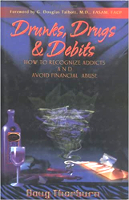
Image by Sarah Lötscher
There is a vast difference between ego and self-esteem, although the observer can easily confuse them. Ego is egotism, an inordinately large sense of self-importance. Concomitant to this is that whatever one does is OK, even though it may violate another's obviously less important space. This may account for much of the criminal and unethical conduct we observe in addicts.
The 12-Step programs work because they are designed to deflate the ego while suggesting steps to help rebuild self-esteem. Bill Wilson and Dr. Bob Smith, co-founders of AA, knew that deflating the massive ego of the alcoholic had to be a fundamental objective of the program. The first three steps of this program, i.e., admitting we were powerless over a substance, recognizing a Power greater than ourselves, and handing our will and our lives over to the care of God (or other higher power) do not come easy to a practicing egomaniac.
Bloated Self-Importance
The 4th Step, that we conduct a searching and fearless moral inventory of ourselves, suggests that there is work to be done on one's character. This is not an acknowledgment made by one who views himself as god-like. Admitting to wrongs (in Step 5) is a clear admission of imperfection, something that must, by definition, deflate the ego of those with a bloated sense of importance. Ready to have God remove all these defects of character implies they cannot do this themselves.
Vernon Johnson identified euphoric recall as the most destructive of the distortions. The fact that this makes the addict remember everything he does in a favorable light could not only inflate one's ego, but it may be the inflated ego's primary cause. While abstinence is the first step towards recovery, this by itself yields only a dry drunk. The ego, although no longer being pumped up, is not being deflated.
Ego deflation is imperative for healthy sobriety, even if it is not the fundamental cause of all the other bizarre conduct and appearance of psychopathological disorders. Sometimes, bewildering actions are engaged in due to the need to insure availability of the substance. At other times, such behavior is a result of extreme mood swings and other dysfunctions, which have the appearance of mental disorders. Eventually, addicts fall to the effects of latter-stage addiction, including financial difficulties and secondary diseases.
Physiologically based blackouts may explain much of the most bizarre and destructive conduct. However, once the bloated ego begins to be deflated, the most consistently destructive behaviors begin to subside. Only then can the rebuilding of self-esteem commence.
Self-Esteem and Responsibility
Self-esteem is regarding oneself with respect and having a favorable view of self. Ask any recovering alcoholic-addict how they viewed themselves while they were using and they will tell you, it was with total disdain. While some may confuse ego with self-esteem (as I did in my addict-ex), make no mistake: the self-esteem of the addict while using is zero.
For recovery to occur and sobriety maintained the ego must be deflated and self-esteem restored. Deflating the ego without rebuilding self-esteem will ultimately cause the addict to self-destruct. Understanding his source of self-esteem, then, is exceedingly important for both him and us if we are to provide real help in recovery.
The suggested Steps to recovery of the 12-Step program are no more suggestions than the advice to not drive over a cliff if one wants to live. Each Step is essential to recovery. Since each builds on the other, it is important that they be worked in order. While the process of deflating the ego is begun in Steps 1 through 3 and continues in Steps 4 through 9, these latter are also geared towards helping the addict rebuild self-esteem. Providing the core of recovery, these Steps require the addict to get and stay honest with both himself and others. Crucially, they admonish that he face up to and experience the consequences of his poor decisions and behaviors.
Recognizing One's Character Flaws
These Steps assist the addict in recognizing his character flaws and personality defects, helping him to take responsibility for his behavior. Milam and Ketcham point out the danger this poses to the addict in leaving him with guilt and shame of massive proportions. They also suggest that some may incorrectly interpret this to mean, "Once his personality problems are fixed, he can return to normal drinking." AA could do more to inform members of the biological basis for the affliction, thereby extinguishing this interpretation. Despite these concerns, Milam and Ketcham agree that AA is "far and away the most effective program in the world for helping alcoholics to stay sober." It likely works as well as it does because Steps 4 through 9 are designed to both deflate the ego and assist in the renewal of self-esteem.
Acknowledging one's flaws, admitting one's wrongs and paying amends to others in truly penitent fashion require ego deflation. Taking responsibility for one's behaviors, living consistently with one's values and core needs, while getting (and staying) honest, begins the process for the restoration of self-esteem.
No Excuses
Those who believe in either the Mental Health Model or excuse models of addiction may not accept this. The Mental Health Model hypothesizes that other psychopathological disorders precede, explain, and cause the addiction. If true, addicts could overcome their disorders through psychological counseling and later resume drinking or using non-addictively. Telling them they have a psychopathological disorder gives them an excuse for their behavior. Counseling is reported by addicts themselves to never result in a cure for substance addiction, but instead to always enable their use. They later find that, once in recovery, the behaviors giving rise to the incorrect diagnosis of behavioral disorders or mental illness have diminished and usually disappear.
The excuse model suggests that the addict cannot be held accountable for his actions and behaviors, since he is either diseased or mentally ill. This flies in the face of the addicts own view on the subject. By their own testimony, recovery from their disease is impossible without taking responsibility. This, along with the consequential rebuilding of self-esteem, is the only way by which the disease can be kept in remission.
Published by Galt Publishing, PO Box 7777, Northridge, CA 91327.
Reprinted with permission. All Rights Reserved. ©2000.
Article Source
Drunks, Drugs & Debits: How to Recognize Addicts and Avoid Financial Abuse
by Doug Thorburn.
 A comprehensive book on alcohol and other drug addiction. Explains how to identify the problem in the earliest stages, before tragedy occurs. Most readers cannot put the book down; they depict it as a "page turner", a description rarely used in regards to non-fiction work.
A comprehensive book on alcohol and other drug addiction. Explains how to identify the problem in the earliest stages, before tragedy occurs. Most readers cannot put the book down; they depict it as a "page turner", a description rarely used in regards to non-fiction work.
Readers comments: "It is a fascinating, but also very useful, description of the behavior of substance addicts, as well as how to spot an addict and to protect yourself from damage." "Doug Thorburn's interest in, and research into the problem of alcoholism and addiction to other substances, has added an invaluable dimension to our understanding of the problem."
About the Author
 Doug Thorburn is a pioneering author and educator researching early-stage alcoholism and other drug addiction problems. His research explains each sign of alcoholism, or symptom of alcoholism or prescription drug addiction. Thorburn's books are acclaimed not only for their powerful self help qualities, but also they contribute to a variety of education programs.
Doug Thorburn is a pioneering author and educator researching early-stage alcoholism and other drug addiction problems. His research explains each sign of alcoholism, or symptom of alcoholism or prescription drug addiction. Thorburn's books are acclaimed not only for their powerful self help qualities, but also they contribute to a variety of education programs.
You can order an autographed copy of his book and receive an update from the author by ordering from the publisher at JustSayNoToAddicts.com. Visit his website at PrevenTragedy.com/
























